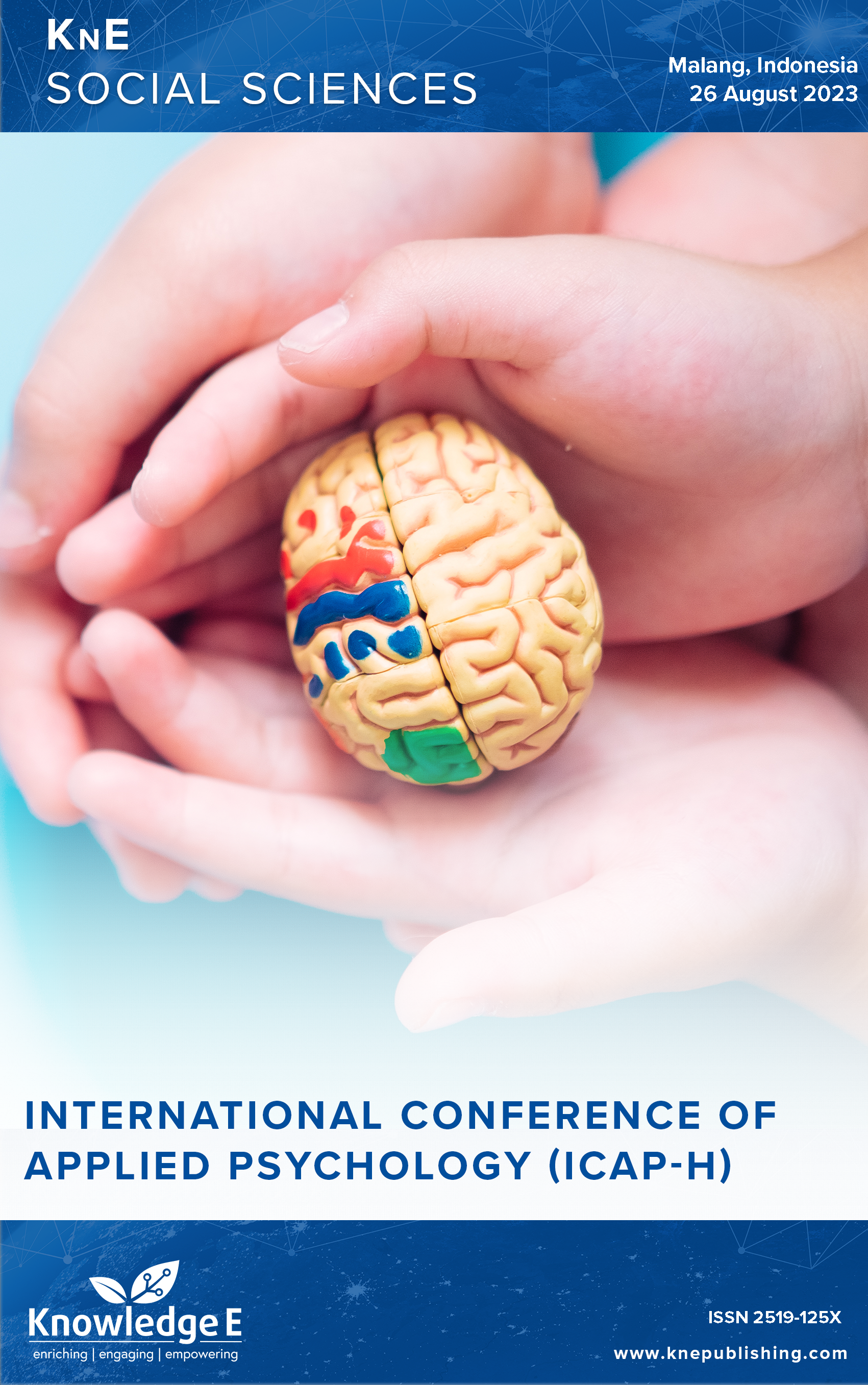Token Economy to Reduce Aggressive Behavior in Adolescent with Intellectual Disabilities
DOI:
https://doi.org/10.18502/kss.v9i5.15160Abstract
Aggressive behavior is often found in individuals with intellectual disabilities (ID). Aggressive behavior arises due to low cognitive capacity so that the ability of individuals with ID to understand situations or the environment has limitations on the other side. The process of understanding the situation and realizing how to respond is very important so that individuals can adapt well to the environment. On the other hand, realizing adaptive behavior in individuals with ID is quite difficult. This research attempts to give an overview of the token economy to reduce aggressive behavior in hitting, shouting, and countering. This study aims to look at the effectiveness of token economy in reducing aggressive behavior in adolescents with ID. The research method used was single case experimental design. Data were obtained through observation, interviews, and psychological tests. Pretest and posttest were carried out on aggressive behavior before and after the treatment. The results of the token economy treatment showed a decrease in aggressive behavior on the subject as a whole (calculated based on a behavioral checklist), both in hitting (formerly 6 to 0), shouting (formerly 9 to 0,2), and countering behavior (formerly 6 to 0.2). There was a decrease from 24 to 3 based on the CBLC score after the treatment. Thus, it can be concluded that the token economy has proven effective in reducing aggressive behavior in adolescent with intellectual disabilities.
Keywords: aggression, intellectual disability, token economy
References
Narayan J. Intellectual disability: A manual for CBR workers. World Health Organization, Regional Office for South-East Asia; 2007.
Ke X, Liu J. Intellectual disability. In: Developmental disorders. Nanjing: Nanjing Medical University; 2012. 1–25 p.
Association AP. Diagnostic and statistical manual of mental disorders (DSM-5®). American Psychiatric Publishing, Inc.; 2013.
Santhanam T, Babu BP, Sugandhi S, Rao DB. Children with learning disabilities. Sonali Publications; 2007.
Foley K-R, Taffe J, Bourke J, Einfeld SL, Tonge BJ, Trollor J, et al. Young people with intellectual disability transitioning to adulthood: Do behaviour trajectories differ in those with and without Down syndrome? PLoS One. 2016;11(7):e0157667. DOI: https://doi.org/10.1371/journal.pone.0157667
Payne J, Patton J. Mental retardation. Columbus, OH: Charles E. Merrill Publishing Company; 1981.
Cooper SA, Smiley E, Jackson A, Finlayson J, Allan L, Mantry D, et al. Adults with intellectual disabilities: Prevalence, incidence and remission of aggressive behaviour and related factors. Journal of Intellectual Disability Research. 2009;53(3):217–232. DOI: https://doi.org/10.1111/j.1365-2788.2008.01127.x
Buss AH, Perry M. The aggression questionnaire. Journal of Personality and Social Psychology. 1992;63(3):452–459. DOI: https://doi.org/10.1037//0022-3514.63.3.452
Berkowitz L. Aggression: Its causes, consequences, and control. Mcgraw-Hill Book Company; 1993.
Elizabeth HB. Psikologi perkembangan. Jakarta: Erlangga; 1980.
Williams V, Hoadley S. Linking up emotional support for young. The foundation for people with learning disabilities. 2005. 28–33 p.
McClure K, Halpern J, Wolper P, Donahue JJ. Emotion regulation and intellectual disability. Journal of Developmental Disabilities. 2014;15(2):39–44.
Muriyawati, Rohmah FA. Pengaruh pemberian token ekonomi terhadap motivasi belajar siswa sekolah dasar. J Pendidik Sekol Dasar. 2016;2:58–72. DOI: https://doi.org/10.26555/jpsd.v2i2.a5535
Matson JL, Estabillo JA, Matheis M. Token economy. Encyclopedia of Personality and Individual Differences. 2016;1–3. DOI: https://doi.org/10.1007/978-3-319-28099-8_956-1
Sturmey P. Treatment interventions for people with aggressive behaviour and intellectual disability. Autism Relat Disord basic Handb Ment Heal Prim care other Prof. 2002;42–56.
Kappel B, Dufresne D, Mayer M. From behavior management to positive behavioral support. Report, Dep Heal Hum Serv Adm Dev Disabil; 2012.
LeBlanc LA, Hagopian LP, Maglieri KA. Use of a token economy to eliminate excessive inappropriate social behavior in an adult with developmental disabilities. Behav Interv. 2000;15(2):135–143. DOI: https://doi.org/10.1002/(SICI)1099-078X(200004/06)15:2<135::AID-BIN51>3.3.CO;2-V
Fiksdal BL. A comparison of the effectiveness of a token economy system, a response cost condition, and a combination condition in reducing problem behaviors and increasing student academic engagement and performance in two first grade classrooms. 2014.
Lakhan R. Behavioral management in children with intellectual disabilities in a resource-poor setting in Barwani, India. Indian Journal of Psychiatry. 2014;56(1):39– 45. DOI: https://doi.org/10.4103/0019-5545.124712
Sugiyono. Metode Penelitian Kuantittaif, Kualitatif, dan R&D. Bandung: Penerbit Alfabeta; 2016.
ASEBA. Child behavior checklist. The SAGE encyclopedia of intellectual and developmental disorders. 2018.
Perone M, Hursh DE. Single-case experimental designs. APA Handb Behav Anal Vol 1 Methods Princ. 2012;( January 2013):107–126. DOI: https://doi.org/10.1037/13937-005
Kunto A. Prosedur penelitian suatu pendekatan praktik. Rhineka Cipta. Jakarta; 2013.
Martin G, Pear J. Behavior modification: What it is and how to do it. 11th ed. Oncology: An evidence-based approach. New York; 2019. 1–425 p.
Martin G, Pear JJ. Behavior modification: What it is and how to do it. Routledge; 2019. DOI: https://doi.org/10.4324/9780429020599
Foxx RM, Meindl J. The performance evaluation of university scientific research project management based on the FAHP. Behav Interv. 2007;22:83–97. DOI: https://doi.org/10.1002/bin.233
Fernandez E. Treatments for anger in specific population. New York: Oxford University Press; 2013. DOI: https://doi.org/10.1093/med/9780199914661.001.0001
Jahoda A, Stenfert-Kroese B, Pert C. Cognitive behaviour therapy for people with intellectual disabilities. Springer; 2017. DOI: https://doi.org/10.1057/978-1-137-47854-2

